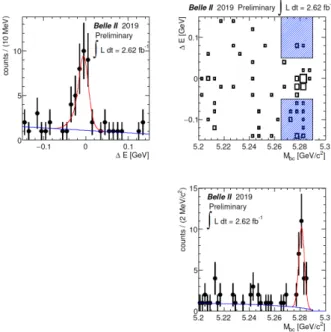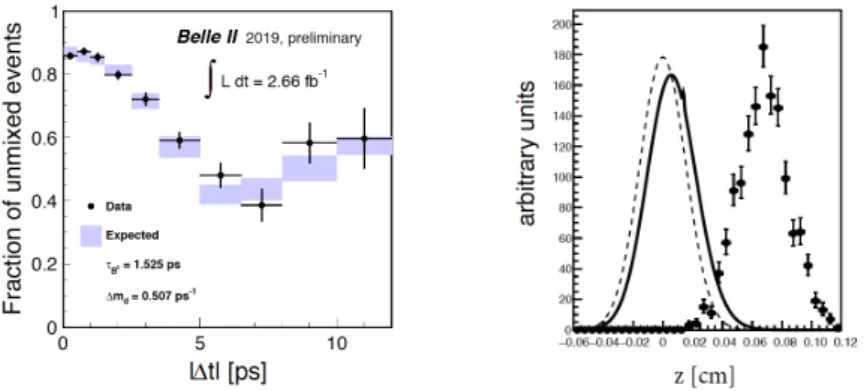FIRST LOOK AT THE TIME-DEPENDENTCP VIOLATION USING EARLY BELLE II DATA
Vladimir Chekeliana
Max Planck Institute for Physics, Munich, Germany
Abstract. The Belle II experiment at the SuperKEKB energy-asymmetrice+e− collider started the first physics run in March 2019 at a center of mass energy corresponding to the mass of the Υ(4S). A first look at the time-dependentCP violation is presented, utilising an early data set comprising 2.6 fb−1 of total luminosity. A new concept of time-dependent fits based on a weighting technique applied to anassistiveMC sample of events is presented as well.
1 Introduction
The mixing-inducedCP violation (CP V) is one of the physics subjects, which could shed light on physics beyond the Standard Model, by making precise measurements of the unitarity triangle. This is an important part of the moti- vation for the new high luminosity experiment Belle II [1] at the SuperKEKB energy-asymmetrice+e− collider. The design luminosity of the new machine is 8×1035cm−2s−1, and the Belle II experiment aims to record 50 ab−1of data, a factor of 50 more than recorded by its predecessor, the Belle experiment at theB-factory KEKB.
The first steps of the time-dependentCP V analysis using an early data set of 2.6 fb−1total luminosity, collected in the spring of 2019, are reported here. One neutralB-meson from the decay Υ(4S)→B0B¯0is reconstructed in theJ/ψKS0 CP-eigenstate decay channel. Then, theCP V parameters and the CKM angle φ1(β) are determined in the fit of the time difference, ∆t=tB0
CP−tB0
tag, between the decay times of the reconstructed signal, B0CP, and the accompanying B meson, B0tag. The flavor of the latter is identified (tagged) from the decay products to be eitherB0(q= 1) or ¯B0(q=−1). At this early stage we report on the observation ofB-decays in the “golden channel”B0 →J/ψKS0 and on the measurement ofB0- ¯B0mixing in semi-leptonic B0-decays.
In this paper a new concept of time-dependent fits based on a weighting technique applied to anassistive sample of simulated MC events is described for the first time, see also [2].
2 Observation ofB0→J/ψKS0 decay and of B0- ¯B0 mixing
The “golden decay channel” B0→J/ψKS0 is reconstructed usingJ/ψ-decays toµ+µ− ore+e−pairs andKS0-candidates, reconstructed from two tracks with opposite charge and common origin in space displaced from theB-decay vertex.
aE-mail: shekeln@mpp.mpg.de
The numbers of signal and background events in data are determined in a two- dimensional unbinned maximum likelihood fit using the beam constrained mass Mbc =p
Ebeam2 −p2cms and the energy difference ∆E=Ebeam−Ecms. Here, Ebeamis the cms beam energy, andpcmsandEcmsare the measured momentum and energy of the B-candidate in the rest frame of the Υ(4S). The Mbc and
∆E distributions of selectedB0→J/ψKS0 events are shown in Fig. 1 together with fit results. The visibleB0→J/ψKS0 yield is found to be 26.9±5.2 events.
Figure 1: Mbc and ∆E distributions forB0 →J/ψK0S events. Fit results are also shown.
Shaded regions are excluded from the fit to remove mainly theB0→J/ψK∗0 background.
This event sample is too small to perform a time-dependentCP V analysis.
The potential of the apparatus in this respect is however demonstrated by the measurement ofB0- ¯B0mixing. Due to the asymmetric energies of thee+ and e− beams, the Υ(4S) is produced with a Lorentz boost of βγ = 0.28. The BB¯ pairs are produced almost at rest in the Υ(4S) frame, and the decay time difference can be determined from the space separation of theB0-decay vertices
∆t ≈ ∆z/(βγc). The high precision of the vertex position measurements of 14.2 ± 0.1µm is proven in data using two-track Bhabha events. This precision is achieved by using the pixel vertex detector (PXD) composed of pixels of 50 × 55 × 75µm3 size, located at 14 mm from the beam axis.
The mixing rate is measured using events with flavor information available for both B-mesons decaying semi-leptonically. Events with opposite charges
of the leptons correspond to B0B¯0 states without mixing. This “unmixed”
sample comprises 1642 ±113 events. The same charges of the leptons indicate that one of the B0-mesons changed flavor due toB0−B¯0 mixing. 253 ± 45
“mixed” events are found. The fraction of mixed events corrected for efficiency, (17.3 ±3.6)%, is in agreement with the expectation of 18.6%. The evolution of the fraction of unmixed events as a function of|∆t|in Fig. 2 (left) is consistent with the expected oscillation pattern of theB0−B¯0 mixing, assuming world averages for theB0-lifetime (τ) and for theB0−B¯0mixing parameter (∆md).
Figure 2: Left: Fraction of unmixed events as a function of|∆t|for B0 →D∗0lν events.
Right: Simulation of the decayz-positions of theY(4S) (dashed line), ofBtag0 if it decays first, i.e. ∆t >0, (solid line) and ofBtag0 for ∆tfrom -8 to -6.7 ps (points).
3 A new concept of time-dependent fits at Belle II
In view of new challenges related to the target statistics and the high precision of Belle II, an alternative paradigm for time-dependent analyses is desirable.
For example, the size of the beam spot is much smaller than the decay length ofB0-mesons on the tag side (700µm and more) for very negative ∆t-values, see Fig. 2 (right). This could cause a variation of the quality of theBtagvertex reconstruction and a dependence of the ∆tresolution function on ∆ttrueand on the underlying physics parameters. In the traditional time-dependent analyses at Belle and BaBar [3], the convolution of theory input and the ∆tresolution function is done analytically assuming their factorisation. To overcome these complications, the new concept [2] is utilising a weighting technique applied to an assistive MC simulated using GEANT and the best knowledge of the detector properties. By that the more precise convolution is taken from the simulation without the need of an intermediate analytical approximation of the
∆t resolution function. The basic principles of the concept are the following:
• an unbinned maximum likelihood fit is used to determine all physics and smearing parameters, with the likelihoodL=Q
iPevi (∆t);
Figure 3: The reconstructed ∆trec distributions for q = 1 (a, c) and q = −1 (b, d) for B0 →J/ΨKS0 MC simulated without (black in a, b) and with (blue in c, d)CP violation.
The MC sample withoutCP V, re-weighted to account forCPviolation, is shown in red.
• the event probabilities Pevi (∆t) are calculated numerically using a dedi- catedassistiveMC sample simulated for the chosen signalB-decays;
• the physics parameters (τ, ∆md and parametersA andS for the direct and mixing-inducedCP V) are varied in the fit by weighting of the events in the assistiveMC sample in such a way that the re-weighted sample is equivalent to a new simulation with new values of physics parameters;
• similarly, re-weighting of theassistiveMC sample is applied for additional smearing of ∆t to downgrade the detector response, with the goal to reproduce in simulation the detector properties of the data;
The additional ∆tsmearing of theassistiveMC is expected to be pretty much the same for all channels in the fit, since the ∆tresolution is dominated by the quality of the Btag vertex reconstruction, which is common for all channels.
Details of the weighting procedures are discussed in the next two sections.
3.1 Re-weighting of an assistive MC sample instead of new physics simulation The theory input for generation and simulation of events is given by the follow- ing probability function depending on the decay time of theB0, which decays first,tB0
f irst, and on the time difference ofBCP0 andBtag0 decays:
Pth= e(−tB0f irst/τ) 4τ
e(−|∆t|/τ)
4τ {1 +q[A·cos(∆md∆t) +S·sin(∆md∆t)]} (1) Re-weighting of the events in the simulated MC sample by the ratio of prob- abilities calculated using a new set of physics parameters and of the set used during simulation, results in a new MC sample, which is fully equivalent to a new simulation with the new set. This is demonstrated in Fig. 3, where red histograms obtained after re-weighting coincide in c) and d) with the blue histograms corresponding to the simulation with the new set of parameters.
Figure 4: The ∆trec distributions for positive (a, c) and negative (b, d) ∆ttrue in the B0 → J/ΨKS0 MC sample without smearing (black), with smearing (blue) and smeared
by weighting (red). The vertical scales are linear in (a, b) and logarithmic in (c, d).
3.2 Smearing of an assistive MC sample by weighting of the MC events The most straightforward and very efficient way to account for differences be- tween data and MC in the detector response is an additional Gaussian smearing of the reconstructed ∆trecin MC, ∆tsmearrec = ∆trec +G(0, αsmear·δ(∆t)), scaled with the uncertainty of ∆trec,δ(∆trec). This Gaussian smearing can be applied before the fit, however, it is not suitable for iterations in the fitting procedure.
Since the resolution function, P(∆trec−∆ttrue), is often approximated by a sum of three Gaussian functions, one can do smearing by weighting of the MC events with the ratio of probabilities of the deviation ∆trec−∆ttrue for modi- fied and initial resolution functions in MC, where the modification is given by replacing all Gauss sigma-parameters,σi, byσsmeari =p
σi2+ (αsmear·δ(∆t))2. In Fig. 4 it is demonstrated for theB0→J/ΨKS0 signal MC andαsmear = 2, that both ways (blue and red histograms) are almost identical. Consequently, the factor αsmear in the smearing by weighting can be used as an additional free parameter in the fitting procedure.
Conclusions
The first 2.6 fb−1of Belle II data collected in 2019 are used to observe the decays B0 → J/ψKS0 - the “golden channel” for measurements of time-dependent CP violation. The feasibility of time-dependent analyses is demonstrated by the measurement ofB0- ¯B0 mixing using events where both B0-mesons decay semi-leptonically. In view of the new challenges related to the target statistics and the high precision of Belle II, an alternative paradigm for time-dependent analyses based on the weighting of anassistiveMC sample is developed.
[1] T. Abeet al.,Belle II Technical Design Report, [arXiv:1011.0352] (2010).
[2] Vladimir Chekelian, The MPI Concept of Time-Dependent Fits at Belle II, The xFitter Workshop, Minsk, 18-20 March 2019,https:
//indico.desy.de/indico/event/22011/session/7/contribution/24/material/slides/0.pdf [3] A. J. Bevan et al., Eur. Phys. J.C74(2014) 3026, [arXiv:1406.6311].



